| Lot |
Photo |
Description |
Realized |
Lot 760 |
 |
Hyaenodon Fossil Skull. Hyaenodon mustelinus was a 30-33 million year old carnivorous mammal and the last surviving family of creodonts that looked something like a hyena with a large head. Hyaenodonds were the most specialized of all creodonts. Their lack of binocular vision may have put them at a disadvantage when competing with other more advanced and faster predators. Their favorite prey was probably oreodonts and when oreodonts became extinct, the Hyaenodons became extinct also. In addition to sharp incisor teeth, Hyaenodon also had carnassial teeth with the last upper premolar and the first lower molar having sharp edges to rip flesh. This 7¼ x 4" medium brown skull is complete with all of the darker brown teeth present including one inch long incisors and sits on a 5" section of original stone matrix as a base. Hyaenodon mustelinus was the smallest and rarest of the Hyaenodon species. This rare specimen comes from an old time collection and was found in Sioux County, Nebraska. Estimated Value $2,500 - 3,000
View details and enlarged photo
| Realized
$1,200 |
Lot 761 |
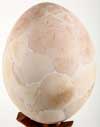 |
Largest Egg Known. The extinct flightless bird Aepyornis maximus produced the largest egg of any animal that ever lived including dinosaurs. This egg is 13 inches high and 9½" high. This was the equivalent volume of 10-12 Osterich eggs or 160 chicken eggs. Aepyornis is commonly known as the elephant bird, a name that originated from Marco Polo's account of the giant bird in 1298. He described the ten foot tall Aepyornis that weighed over half a ton as having talons large enough to seize an elephant. Aepyornis was the largerst bird that ever lived and only became extinct in the middle of the 17th century. Aepyornis only lived on the island of Madagascar and the pieces of original shell from this bird have been reconstructed to form this huge impressive egg. The fossil shell is 10,000-20,000 years old and was found in the southern sands of Madagascar. Great care and time was spent in matching the sizes, curvature, and color of the egg fragments to put the egg back to its normal shape and size. This egg is a cream to light tan color with more than 65% of the egg fragments from the same egg and most of the remaining shell from one other egg. The egg is quite solid and stable. There are only about a dozen unbroken Aepyornis eggs known, most in museums with one selling at auction for over $35,000. This huge egg comes perched on a hand carved wooden stand for a very dramatic display. Estimated Value $2,500 - 3,000
View details and enlarged photo
| Unsold |
Lot 762 |
 |
Important Possible Dinosaur Feathers In Amber. Most amber is too young to have dinosaur feathers in it, but Burmite is the name for 100 million year old amber found in the Hukawang Valley in northern Burma (Myanmar). It was one of the scientific stories of the year several years ago when possible dinosaur feathers were found in 80 million year old Canadian amber. More than 40,000 Canadian amber specimens were examined from a museum collection which resulted in about a dozen of amber nuggets that contained feathers. The distinction of what constitutes a dinosaur and an early bird is somewhat blurred. Both Coelerasaur and Tyanosaur dinosaurs are known to have been feathered from the outstanding fossils that have been found in Liaoning, China which have been dated from 110-130 million years old. Both the diversity and preservation of the possible dinosaur feathers preserved in Burmite exceed that of the Canadian amber. This 20 x 18 mm clear golden yellow Burmite amber nugget contains four or five beautifully preserved feathers about 15mm in length. In shape and form these feathers are quite similar to semiplume feathers found on birds. These remarkable feathers have a small weak central rachis and very fine barbules without hooks This creates a fluffy insulating structure that is not useful for flying but is useful for warmth. This supports the theory that feathers first evolved for insulation and display and only later evolved into flying feathers. These feathers have remarkable detail and even though their actual color is not preserved, it could be determined from examining the shape of its microscopic pigment making structures know as Melanosomes which determine the color of the feather. By using modern birds as examples, the shape of the preserved Melanosomes will tell us if the feathers were black, gray, red or rusty brown and thus what color the feathers were in the feathered dinosaurs. These colored Melanosomes were found in the preserved dinosaur feathers in Liaoning fossils and would almost certainly be present in these even better preserved feathers in Burmite. Presented in a 8 x 6" Riker mount with an enlarged photo of the important dinosaur or early bird feathers. Estimated Value $2,500 - 3,500
View details and enlarged photo
| Realized
$3,120 |
Lot 763 |
 |
Large Plate of Six Complete Dinosaur Footprints. This large 25 x 12" brownish gray plate contains six complete positive dark gray dinosaur footprints. These detailed dinosaur footprints are over 200 million years old and were found in the Portland Formation of the Connecticut Valley. These dinosaur footprints were made by a bipedal theropod dinosaur. It is not known what species of theropod dinosaur made these prints so the prints are given their own scientific name based on the size and shape of the prints. The largest print is a rare Anchisauripus minusculus. There is also a 6½" Anchisauripus footprint with beautiful pads and claw preservation that extends above the matrix. There are also four other complete Anchisauripus tracks in the six inch range that also have well defined pads and claw details. It is quite rare to find so many excellent dinosaur tracks on one plate. Estimated Value $1,500 - 2,000
View details and enlarged photo
| Unsold |
Lot 764 |
 |
Partial Lizard in 100 Million Year Old Amber. One of the rarest and most desirable of creatures in amber is that of a lizard. Most animals including lizards are too big to be trapped in the small amounts of tree resin that fell on the ground 100 million years ago. A much younger 25 million year old lizard in Dominican Amber sold for $50,000. Burmite is 100 million year amber that is found in the Hukawng Valley of Myanmar (Burma). This remarkable 1¼" long partial lizard encased in a 1½ x ¾ inch clear orange colored amber nugget shows most of the body and tail with two leg stubs and a blob of skin where the head should be. Lizards are seldom complete in amber because even though their body is encased in amber which is dessicating, the bacteria contained within their body lives long enough to break down the soft tissue of the lizard's body.
This rare lizard in amber is housed in a 8 x 6" Riker mount with a photo of the lizard. Estimated Value $1,500 - 2,000
View details and enlarged photo
| Unsold |
Lot 765 |
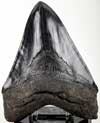 |
Carcharodon, Megalodon Shark's Tooth. Carcharodon megalodon was the largest shark that ever lived growing to more than 50 feet in length and ate whales whose bones are found right alongside with the huge teeth of megalodon. This immense 6¼" on the diagonal and a huge 4½" wide 15-20 million year old Carcharodon tooth was found in the muddy river waters of South Carolina. Estimating the length of a shark at about 10 feet in length to every one inch of tooth, this behemoth would be over 60 feet long. This huge tooth has lovely greenish-gray enamel, a complete black root and good serrations(though not sharp) on the edges. There appears to be some restoration done along the right edge of the blade. This restoration was professionally done and the color matches the color of the original enamel perfectly and is only visible under magnification. The size of this tooth is very desirable being over the magic 6 inches and wider than usually found .
This gigantic tooth conveys with a custom stand for display identified as Megalodon. Estimated Value $750 - 1,000
View details and enlarged photo
| Realized
$780 |
Lot 766 |
 |
Ancient Piranha Phareodus. This large 12 inch long 5 inch wide Phareodus encaustus, an ancient ancestor of the Piranha, is remarkably well preserved with light beige and brown scales, detailed fins and several sharp teeth attesting to it being a fearsome predator. This fearsome predator is complete except for some of the delicate fin bones. It does have a 1.5 inch unusual thin ventral fin that was used to detect fish movement in the sea bottom. This attractive 52 million year old predatory fish from Green River, Wyoming is nicely displayed on a 14½ X 12½ inch limestone slab. There is no restoration. Estimated Value $700 - 900
View details and enlarged photo
| Unsold |
Lot 767 |
 |
Tyrannosaur Toe Claw. Albertosaurus sarcophagus was a large Tyannosaur theropod older and smaller than its more famous cousin Tyannosaurus rex. This large 4¼" toe claw is 70-80 million years old and was found on a private ranch in the Two Medicine Formation of Glacier County, Montana. This large brown toe claw is complete but slightly distorted in burial with nice grooves and blood grooves on one of its sides. There has been no restoration except for a little crack filling as is usually the case for Tyannosaur teeth and claws. Claws are much rarer than teeth because dinosaurs replaced their teeth but only had one set of claws for their entire life. Comes with a small plastic stand for display. Estimated Value $700 - 1,000
View details and enlarged photo
| Unsold |
Lot 768 |
 |
Two Museum Quality Spiny Trilobites. There are many different varieties of spiny trilobites found in Jjebel, Issoumour Morocco more than 375 million years ago. There must have been an arms race going on with the trilobites developing sharp spines to protect themselves from being swallowed whole by carnivorous worms and other predatory sea creatures that did not have teeth. Toothed fish did not exist at this time, only jawless fish. These trilobites are very spectacular and require many hours of tedious work to reveal the delicate spines. This gives them an amazing life like appearance compared to the usual quality where the spines are flattened or missing entirely.
This pair of complete 3-D Cyphaspis are certainly bizarre with two horns jutting from their head, short eye stalks and long sharp genal spines protecting their bodies. Dramatically positioned on a 3½ X 2" grey matrix, the largest specimen is 1.4 inches long and the smaller one 1 inch long. Estimated Value $700 - 900
View details and enlarged photo
| Realized
$660 |
Lot 769 |
 |
Huge Plate With Over 40 Starfish. This large 15 x 15" plate is 150 million years old from the famous fossil site of Solnhofen, Germany. This remarkable lithographic limestone slab contains more than 40 starfish 1-1½" in diameter of the Sinosura species. Sinosura was a brittlestar. Brittlestars are smaller and more delicate than the traditional starfish. Their five arms branched off of the central disk and could move independently of each other. Most of these starfish are complete and a medium brown color which contrasts nicely against the light beige limestone matrix. Even though many beautiful fossils are found at Solnhofen, many tons of limestone have to be removed to find even a single fossil. It is truly remarkable to have so many fossil starfish on one plate. Estimated Value $700 - 900
View details and enlarged photo
| Unsold |
Lot 770 |
 |
Duckbill Dinosaur Partial Maxilla Teeth. Edmontosaurus annectens was a very large herbivore that was a favorite food choice for T-Rex. It is known as a Duckbill dinosaur because of its wide toothless beak. Behind the beak were rows of hundreds of replaceable teeth in its back jaw and Maxilla. This 3½ x 4¼ " long section of the Maxilla has 11 original teeth, fragments of replacement teeth and outstanding bone detail. The fragments of the replacement teeth can be seen on the edges of the maxilla. It is 65-67 million years old and was found on a private ranch in the Lance Creek Formation of Niobrara county Wyoming. It is sold with a 2½ x 1½" plastic stand for display. Estimated Value $650 - 800
View details and enlarged photo
| Unsold |
Lot 771 |
 |
Therizinosaur Dinosaur Egg. This rare dinosaur egg is very distinctive in being from the rare and poorly understood class of dinosaurs known as Therizinosaurs. Therizinosaurs were some of the strangest looking dinosaurs having some features of a plant eating dinosaur and some features of a theropod dinosaur. They had a small skull on a long neck with a large gut which resembled a plant eating dinosaur, but also were bipedal, had filamentous feathers, and extremely large hand claws up to three feet long in the largest species, like a theropod dinosaur.
Therizinosaur eggs come in various sizes depending on what species deposited the eggs. between 80-90 million years ago in Asia. This fully prepared 3.5X2 inch(air brushed) black egg is in good condition being unhatched with over 70 percent of its original shell on the top side and 20 percent on the bottom side with its original brown matrix showing in the missing areas. Therizinosaur dinosaur eggs are much scarcer than Hadrosaur or Oviraptor eggs and are rarely offered for sale. Comes with a3.25 inch illusion stand for display. Estimated Value $600 - 850
View details and enlarged photo
| Realized
$408 |
Lot 772 |
 |
Huge 17" Diplomystus. Some of the best preserved fish in the fossil record are found in the 50-52 million year old Green River Wyoming fossil fresh water lake beds. The vast majority of the fish found are small measuring only 2-4 inches long. This museum quality lot is the exception with a huge 17 inch long (close to the maximum size) Diplomystus which was an extinct member of the herring family. The huge fish is complete with outstanding skin, fins and even some sharp little teeth in its distinctive upturned mouth which enabled it to feed on small fish and creatures near the surface of the lake. The dark brown fish is nicely contrasted on the cream colored 28 x 18" sandstone matrix. This museum quality fish has been framed with a dark brown frame and is ready to be hung if so desired (hooks attached on back.). Estimated Value $600 - 800
View details and enlarged photo
| Unsold |
Lot 773 |
 |
Two Gigantic Trilobites. There are two giant Acadoparadoxites trilobites on a 25X17 inch matrix. Acadoparadoxites was
one of the largest and very earliest trilobite (over 500 million years old) that ever lived. This gigantic trilobite was one of the largest predators of the mid Cambrian warm seas of Morocco. Found in the Atlas Mountain range of Morocco, these 15X11 and 14X11 inch trilobites have an attractive medium brown color which nicely contrasts the gray matrix. Both trilobites are virtually complete with only minor restoration on a few of the spines on the cephalon (head) on both of the trilobites where the two trilobites slightly overlap. With most trilobites being only an inch or so in length, finding a museum quality specimen of such giant trilobites is a very rare occurrence. Estimated Value $600 - 750
View details and enlarged photo
| Realized
$420 |
Lot 774 |
 |
Six Pyritized Russian Ammonites. Some of the most beautiful ammonites come from a small 160 Million year old section of the Volga River in the Ulianosk area of Russia. These Kosmoceras species ammonites are so highly value because of the beauty of their fossilization. There are six 1½ x 2" ammonites naturally displayed in a 4½ x 5 x 4¼" stone block. The shells of the ammonites are an iridescent golden brown color with the interiors filled with pyrite also know as fools gold. Pyrite preservation in ammonites is very rare and only in this small section of the Volga River were conditions just right for this beautiful pyrite preservation.This aesthetic grouping is 100 % natural with no restoration. Estimated Value $550 - 675
View details and enlarged photo
| Realized
$408 |
Lot 775 |
 |
Huge Mammoth Tooth. This complete massive dark brown Mammoth tooth is 13 inches long 4 inches wide with a 9 inch root. This is one of the largest Mammoth teeth ever offered for sale undoubtedly from an old mature Mammoth. This huge tooth is 30,000-50,000 years old from Siberia where the best preserved Mammoths have been found. The flat surface of Mammoth teeth was used to grind coarse vegetation. The alternating rows of raised dark brown hard enamel and brown recessed softer dentine are clearly visible. The only negative on the tooth is that parts of the root were broken in shipping and have been glued back together making it complete. Some of the glue still shows on the bottom of the tooth. It is not perfect but it is massive and impressive. Estimated Value $500 - 700
View details and enlarged photo
| Realized
$324 |
Lot 776 |
 |
Duckbill Dinosaur Neck Vertebrae. This virtually complete 6 x 3¾ x 3½" dinosaur neck vertebrae is from a Duckbill Dinosaur that lived in the Two Medicine Formation of Teton County, Montana 70-80 million years ago. Plant eating Duckbill dinosaurs were named for the duck-like shape of their skulls. All four processes which were the attachments for ligaments and muscle and the central round canal for the spinal cord are very well preserved with the only restoration being re-attaching the processes of the vertebrae. Is sold with a plastic stand for display. Estimated Value $500 - 650
View details and enlarged photo
| Realized
$300 |
Lot 777 |
 |
Bizarre Trilobite with Long Eye Stalks. Neoasaphus kowalewski was a very strange looking trilobite with extremely long one inch eyestalks and must have looked like something from another planet as it crossed the warm ocean floor 450 million years ago in the Wolchow river near St. Petersburg, Russia. This strange trilobite would bury itself in the sand with just its eyestalks exposed to hunt small prey animals and also protect itself from predators. This lovely complete brown trilobite is 2½ inches long on a 4 inch x 3½ inch limestone matrix. The best preserved and most beautiful life-like trilobites in the world come from Russia and are stunning with their medium brown color contrasting the light tan matrix. Neoasaphus kowalewski is certainly one of the strangest and most interesting. Estimated Value $500 - 700
View details and enlarged photo
| Realized
$600 |
Lot 778 |
 |
Leptaucheria Mammal Skull. Leptaucheria was a 30 million year old strange early mammal that was an ancestor of both pigs and camels having some features like a pig and others like a deer. It was a scarcer type of oreodont that may have been an aquatic swimmer or a tree climbing animal. No one knows for sure but its larger eyes sit high up on the skull which is indicative of an aquatic mammal. This impressive 3.75X2.25 inch skull is virtually complete with the back of the skull still within its stony matrix. The very large eyes are lemur-like in size pointing to perhaps a nocturnal life style for Leptaucheria. The teeth have lovely beige enamel and are complete where exposed. This weird mammal of the White River Badlands of South Dakota and is sold mounted on a custom 3 X 1½" inch wooden stand. Estimated Value $500 - 700
View details and enlarged photo
| Realized
$313 |
Lot 779 |
 |
Libyan Desert Glass and Indochinite Tektites. Tektites are a mixture of earth rocks mixed with a sprinkling of meteorite material from an immense explosive event that occurred when a very large rocky meteorite vaporized before impacting the earth. The resulting mixture forms glass-like mixture. The color is usually black such as the 473 gram 4X3.5 inch large specimen from Thailand. It can also be green or yellow if the tektite is formed from sand (silica) such as the 213 gram 4 x 2¼" inch large specimen of Libyan Desert Glass. Both specimens are much larger than normally found. The large black Indochinite looks something like a black piece of petrified wood with a bark-like surface and several areas of glossy black glass areas. The yellow-green Libyan desert glass has a surface of small depressions looking something like regmaglypts that resulted from gasses escaping when they were solidifying in the atmosphere before being redeposited on the ground. The large 213 gram specimen of Libyan Desert Glass was found in the Sahara desert near the border between Libya and Egypt. This an opportunity to acquire two large very different types of tektites. Estimated Value $500 - 700
View details and enlarged photo
| Unsold |
Lot 780 |
 |
Duckbill Dinosaur Egg. This large prepped Duckbill dinosaur egg is 70-80 million years old from Central Asia and is 6 x 5" and has virtually 100 percent of its original shell intact on its top side The bottom side of the egg just shows a little shell. Even though the top of the egg is uncrushed with excellent shape, the bottom of the egg is somewhat flattened. The egg shell is a medium brown color and has been professionally airbrushed to remove the overlying stone matrix. There is no restoration. The top side of the egg is as good as it gets with a dinosaur egg and displays nicely on a 3½ x 2½" plastic stand. Estimated Value $500 - 750
View details and enlarged photo
| Realized
$408 |
Lot 781 |
 |
Large Patty Type Dinosaur Coprolite. Coprolites are the fossilized excrement of animals. They are studied by Scatologists to find out about the diets of the animals that deposited them. Dinosaur coprolites are among the most valuable and interesting. The relatively flat patty-type coprolites are one of the scarcer types and can definitely be attributed to a herbivorous plant eating dinosaur. Although, the exact species cannot be identified, a sauropod dinosaur that is found in the 150 million year old Morrison Formation of Utah is the most likely dinosaur. This complete 10 x 5½" coprolite has had about a one inch slice taken from one end of the coprolite and polished to show the lovely colors of the organic material that was fossilized in the coprolite Also, the cut surface of the main section was also polished to show the various shades of browns, grays and burnt orange against a dark gray to black background. Estimated Value $500 - 650
View details and enlarged photo
| Realized
$313 |
Lot 782 |
 |
Large Milliede in 100 Million Year Old Amber. One of the oldest found formations of Amber comes from the Hukawng Valley of Burma (Myanmar). This amber (known as Burmite) is 100 million years old or slightly older which makes it twice as old as the 50 million year old Baltic amber and 4 times as old as the 25 million year old Dominican amber. This amber was deposited when the dinosaurs ruled the earth and contains many species of extinct insects. This mostly clear 22 x 19 mm piece of Burmite contains a large millipede 18mm in length that is virtually complete missing just its back end but clearly shows it head with two antennae and some its many legs. There is also a small wasp. Comes in a 6 x 5" Riker mount with an enlarged photo of the millipede. Estimated Value $450 - 600
View details and enlarged photo
| Realized
$660 |
Lot 783 |
 |
Collection of Four Amber Specimens of Rarer Insects. Dominican amber comes from the fossilized resin from the extinct species of Hymenaea protera trees. This amber is of a high quality and transparency. The insects preserved within this amber are over 25 million years old and are found in the mountainous region north of Santiago. This collection of 12 - 20mm clear amber nuggets contains a number or rarer and more interesting insects. 1. Pseudoscorpion 2. Polyxenid millipede and spider 3. Spider and 4. Stingless bee
This interesting collection conveys with enlarged color photographs of the insects and is housed in a 5½ X4½" Riker mount. Estimated Value $400 - 600
View details and enlarged photo
| Unsold |
Lot 784 |
 |
Aquatic 150 Million Year Old Reptile. Sinohydrosaurus lingyuanensisgen was a strange looking aquatic reptile with a very long neck that lived 150 million years ago in fresh water lakes in Liaoning Province, China. Sinohydrosaurus translates to Chinese water dragon. This 5.25 inch specimen on a 6.5X4.25 inch tuffaceous volcanic rock matrix is virtually complete (missing only a few of the delicate claws and digits in the feet) with all four legs, tiny rib bones and most importantly an excellently detailed skull. Sinohydrosaurus may be an ancient relative of the fierce Komodo Dragon. This excellent quality specimen is preserved in a 8.25X6.25 inch Riker Mount. Estimated Value $400 - 600
View details and enlarged photo
| Realized
$360 |
Lot 785 |
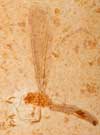 |
Dragonfly in Flight. This 100 million year old dragonfly has been fossilized looking like it was captured in flight. The 1.5 inch dragonfly with 1.5 inch wings is from the famous Santana Formation of Brazil. Two of the dragonfly's wings are almost together giving the illusion of their being just one wing. The brown-orange dragonfly contrasts nicely against the 4.25X4.25 inch sandy color natural limestone matrix. In a 6X5.5 inch Riker mount. Estimated Value $350 - 500
View details and enlarged photo
| Realized
$360 |
Lot 786 |
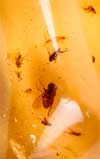 |
Two Large Amber Nuggets With Insects. These two large museum quality clear honey(amber) colored amber nuggets are from Colombia and contain many insects. The first 3.5X1 inch 40.6 gram specimen contains more than a dozen insects including several species of flies including two with bright red compound eyes, fleas and a couple of beetles. The second 3.35 x 1.8" 54.6 gram gem specimen contains several different species of flies, mites and beetles. The absolute age of young Colombian amber or copal cannot be determined as amber itself cannot be tested and dated, but from the quintessential amber color and hardness of these slabs and nuggets, experts suggest their age to be at least 1-5 million years old and probably much older. By using a magnifying glass the detail is amazing. Estimated Value $350 - 450
View details and enlarged photo
| Unsold |
Lot 787 |
 |
Three Complete Black Russian Ammonites. This 250 million year old completely natural reddish-brown stone block contains three complete 1½ to 2¾" black Russian Ammonites plus several partial ammonites. These unusual black color ammonites also consist of three different species Popanoceras, Marationites and Dolorthoceras. These Permian ammonites are completely natural with no restoration. Estimated Value $350 - 450
View details and enlarged photo
| Realized
$210 |
Lot 788 |
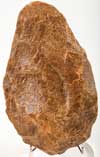 |
Hand Axe from Homo Heidelbergensis. This extremely large 5.¾ x 3½" hand axe is from the Achelean and is between 120,000 to 300,000 years old and was sculpted out of stone by an archaic Homo species such as Homo heidelbergensis that may have been one of the direct ancestors of Homo sapiens. This large heavy hand axe probably had multiple uses from cutting meat to use as a weapon. This 5¾" medium brown hand axe was chiseled by hand by an early homo species to form a sharp point, sharp edges and flat side that fits perfectly in the palm of the hand. These hand axes may have been made over the period of thousands of years and were found in the Western Sahara Desert. This is a rare and interesting early human artifact that shows that the early humans hand hands similar in size and shape to our own. Sold with a 4 inch illusion stand for display. Estimated Value $350 - 450
View details and enlarged photo
| Realized
$384 |
Lot 789 |
 |
Large Madagascar Ammonite. Ammonites were early mollusks that somewhat resembled an octopus or squid living within a protective shell and are the closest relative to the chambered nautilus which still exists today. This large 8 inch diameter 110 million year old ammonite, Cleoniceras was found on the large island of Madagascar. This complete ammonite has its nacre (mother of pearl) polished to reveal its beautiful iridescent beige and brown shell with flashes of red. The only defect is a ½ x ½ inch chip in the mother of pearl which only shows on the bottom of the living chamber on one side.
Presented on a 4" illusion stand for display. Estimated Value $350 - 500
View details and enlarged photo
| Unsold |
Lot 790 |
 |
Iridescent Scaphite Ammonite. Scaphites are a heteromorphic ammonite which means that for some reason they started out forming the usual spiral shape of ammonites but then began to straighten out. This spectacular complete 75 million year old 2½ x 2¼ "colorful ammonite is on a 4 x 3¾" matrix and comes from the Pierre Shales of South Dakota. This spectacular ammonite still has over 75% of its original mother of pearl that has iridescent pinks, greens and purples with the layer beneath the original outer shell being mostly iridescent green with hints of purple. Ammonites possessing such beautiful iridescent colors are now considered to be a gemstone known as ammonite. These spectacular colors are created by minerals being absorbed in the fossilization process. Estimated Value $350 - 450
View details and enlarged photo
| Realized
$204 |
Lot 791 |
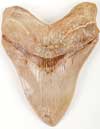 |
Carcharodon Megalodon Shark's Tooth. Even though Carcharodon megalodon was the largest shark that ever lived growing to more than 50 feet in length, most of the teeth found are only 3-4 inches in length. This 4.66 inch long 15 million year old Carcharodon tooth was found in the muddy river waters of South Carolina. This fairly large tooth has beige colored excellent quality enamel, a dark brown root and very sharp serrations. There is a small chip on the point and some restoration on the upper left side of the dark root plus a small amount on the upper left enamel just below the root. This expert restoration matches all of the original colors very closely leaving an impressive looking tooth. Displayed on a 2 inch illusion stand. Estimated Value $300 - 400
View details and enlarged photo
| Realized
$188 |
Lot 792 |
 |
Albertosaurus Dinosaur Tooth. Albertosaurus was a somewhat smaller version of its more famous cousin T-Rex growing to just over 30 feet long. Unlike T-Rex, Albertosaurus had two short bony crests above its eyes and was also older than T-Rex at 70 million years old and found only in the Judith River Formation of Montana and Canada. This 2½" brown tooth has one excellent side with complete dark brown enamel with excellent detail that shows the growth ripples somewhat like the growth rings in a tree. There are also good serrations on the bottom side of the tooth The serrations on the top of the tooth are missing and 80% of the enamel is missing on the back side of the tooth. This tooth is very large for an Albertosaurus and is contained in a 5½ x 4¼" Riker mount. Estimated Value $300 - 450
View details and enlarged photo
| Realized
$192 |
Lot 793 |
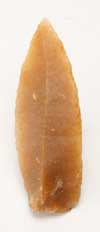 |
Flint Solutrean Point. Superb unifacial projectile point of translucent earth-brown flint in the classic Solutrean, elongated leaf shape. The knapped side bears a raised central spine along the long axis. From the "La Princerie" field across the Creuse River from Grand Pressgny. Ca. 20,000 B.C. 2½" long. Ex: Caldwell Coll., France. Estimated Value $300 - 500
View details and enlarged photo
| Realized
$180 |
Lot 794 |
 |
Impressive Collection of North American Arrowheads, Palmillas, Projectile Points. Nicely assembled collection of Ancient Native American Indian arrowheads. First a riker mount full of 22 Palmillas 1 -1½" in length from the Central Texas Region. Colloquially called "bird points" most still have their tips. All have glue residue on verso from being mounted to a 1950s era display, easily removed without harm using a household solvent. Next is an extremely impressive and large transitional archaic spear point found in South Texas almost 5" in length. and 1¼ at the base in superb condition. In a third mount a collection of 5 projectile points likely from the Missoui State area all roughly 2 x 1½". Finally three loose points from Central to Northeast Texas in perfect condition. An excellent collection for the novice or advanced collector. Estimated Value $250 - 500
View details and enlarged photo
| Realized
$456 |